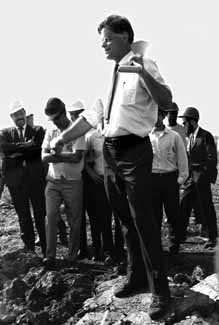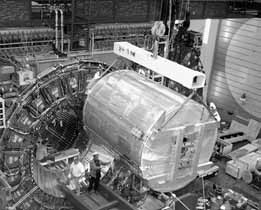 |
|
Y2K: That Was the Year That Was by Mike Perricone
The year began with a small but valiant group of selected staff members standing watch at the lab by night for the dreaded Y2K bug. But midnight brought just another tick of the clock, and there was no computer infestation marking the transition from December 31, 1999 to January 1, 2000.
Time had more important lessons to impart.
"His spirit invades every corner of this great laboratory," said Nobel Laureate Leon Lederman, who succeeded Wilson as director. "He speaks to us through the surfaces of precast, through the prairie restoration, through the style of openness, through the flags that grace the entry."
An eloquent spokesman for science, Wilson had a memorable exchange with Senator John Pastore in hearings of the Joint Congressional Committee on Atomic Energy in 1969. Sen. Pastore asked the value of a national accelerator laboratory to the country's defense.
"It has nothing to do directly with defending our country, except to make it worth defending," Wilson replied.
Wilson was interred in the Pioneer Cemetery on the lab site in private memorial ceremonies on April 28.
Just a few weeks earlier, work had begun on the largest civil construction project in the laboratory's history, the $30.5 million excavation of the target tunnel for the Main Injector Neutrino Oscillation Search. MINOS will send a neutrino beam through the earth, destined for a detector in a mineshaft a half-mile underground in Soudan, Minnesota, some 450 miles away. The goal: precision measurements of neutrino mass.
The official groundbreaking for the project served up its own anticlimax on May 31. Roiling thunder-storms sent dignitaries fleeing for cover and moved the ceremonies indoors, nearly blowing away the pavilion tent intended as the setting. The symbolic shovels of earth were turned at a planter in the Wilson Hall atrium.
But concerning money, the gathering storm was more representative of the year than was the rich earthmoving contract. The lab faced a shortfall of some $30 million in the budget for FY2001, relative to what was needed for continuing the research program without interruption; in fact, the entire high-energy physics community felt the pain of shortfalls.
Fermilab Director Michael Witherell was among the strong voices urging reconsideration in Washington, especially during a March 9-10 meeting of the High Energy Physics Advisory Panel at Fermilab. Witherell stressed the impact of the FY'01 budget for years to come. Stanford Linear Accelerator Center Director Jonathan Dorfan warned of wasting the achievements of previous years; HEPAP chairman Fred Gilman noted the extraordinary circumstances of the budget crisis, and DOE's Peter Rosen urged formulating a national plan for the high-energy physics community.
The lab's Physics Advisory Committee convened in Aspen, Colorado on June 17 without knowing the budget outcome. But the PAC endorsed the proposal for the $150 million BTeV project. This experiment in the physics of the bottom quark at the Tevatron was described as an "ambitious" experiment with "an elegant and challenging detector," which "could be the definitive experiment that ultimately clarifies the picture of CP violation." If not the budget picture.
But another picture was clarified with the July 21 announcement of the first direct observation of the tau neutrino, the third type or flavor of neutrino, and the most elusive of the three, in the Standard Model. The DONUT experiment (Direct Observation of Nu Tau) had evidence for four signature events for the tau neutrino among six million interactions over two years.
The best news for the year ahead came during a Sept. 27-28 visit to the lab by Millie Dresselhaus, the new Director of the Office of Science at DOE. The lab began receiving news that the House-Senate conference had produced a budget agreement in Washington, yielding more than $726 million for High-Energy Physics in FY'01. The $277 million for Fermilab was still below the lab's estimate to run all experimental programs and keep projects on schedule, but most of the $30 million shortfall had been recovered.
And almost immediately after Witherell said "the scientific opportunities make a very compelling case" to justify significant increases in FY2002, the Higgs raised the stakes.
In Geneva, Switzerland, scientists at CERN were announcing "tantalizing hints" of seeing the Higgs particle, postulated by Peter Higgs and others as the source of mass for all fundamental particles. But the European Particle Physics laboratory was about to shut down the 11-year run of the Large Electron-Positron Collider to make way for the Large Hadron Collider. A one-month extension yielded no further evidence, and on Nov. 8, CERN Director-General Luciano Maiani announced that LEP had been turned off "for the last time."
Chris Tully, a CERN experimenter from Princeton University, was widely quoted when he termed Fermilab "the next up to bat," and a suspected mass range around 115 GeV/C2 put the Higgs squarely in Fermilab's sights for Run II beginning in March, 2001. Fermilab became the center of a flurry of media attention in Europe and across the U.S.
The Higgs was news. Science was news. Fermilab was news. The new year would bring yet another challenge. We were sure that somehow, Robert Rathbun Wilson knew and approved.
|
| last modified 12/15/2000 email Fermilab |
FRLsDFx9eyfrPXgV
 Robert Rathbun Wilson, Fermilab's founding director, died on January 16 in Ithaca, New York, following a long illness. He was 85. Wilson was the Wyoming cowboy who built the world's highest-energy particle physics laboratory with the eye of an artist, the shrewdness of a banker, and the conscience of a human rights activist.
Robert Rathbun Wilson, Fermilab's founding director, died on January 16 in Ithaca, New York, following a long illness. He was 85. Wilson was the Wyoming cowboy who built the world's highest-energy particle physics laboratory with the eye of an artist, the shrewdness of a banker, and the conscience of a human rights activist.
 And while budget talks continued in Washington, the lab continued with upgrades for Collider Run II of the Tevatron and the new configuration including the Main Injector. The 800-GeV fixed target program reached the end of the line, closing out a major era in Fermilab's history that had produced the bottom quark discovery and many other significant contributions to the field. But milestone after milestone pointed to an auspicious start for Run II:
And while budget talks continued in Washington, the lab continued with upgrades for Collider Run II of the Tevatron and the new configuration including the Main Injector. The 800-GeV fixed target program reached the end of the line, closing out a major era in Fermilab's history that had produced the bottom quark discovery and many other significant contributions to the field. But milestone after milestone pointed to an auspicious start for Run II: